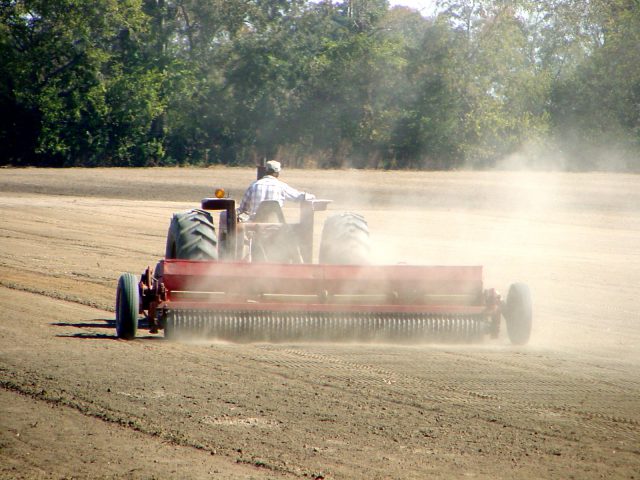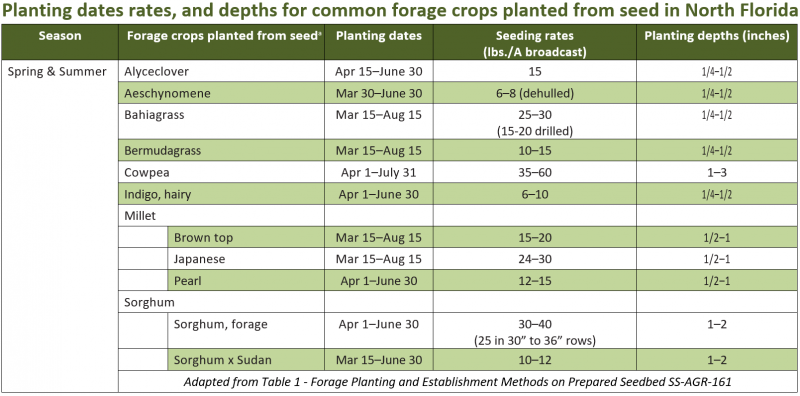–
I have received a number of calls recently with questions about pasture planting. There are a number of reasons to plant or re-plant pastures, whether you are converting crop or timber land to pasture, renovating a field that had been overtaken by weeds, or restoring fields torn up by debris removal equipment after the hurricane. There are seven key steps that should be taken to ensure successful pasture establishment.
–
1 – Develop a Plan
One of the most common issues I run into with pasture planting failures is that people were in such a hurry to get grass planted, that they try to do everything all at the same time. That rarely provides excellent results. You really need to develop a step by step plan that addresses the challenges and management requirements of a new pasture.
–
2 – What to Plant
There are a number of annual and perennial warm season forage options for the Florida Panhandle. The first decision is what to plant? Start with a visit to your local farm supply dealers to find out what species, variety and cultivar options are readily available. If bahiagrass is the forage of choice, you might want to read What is the Best Grass for Pastures in the Panhandle, and another good publication is UGA Management and Use of Bahiagrass. The University of Georgia Forages website also has links to information on a wide range of forage species and variety options. Just recognize that forages such as fescue, orchard grass and timothy, that can be grown in the North Georgia Mountains, won’t grow well in this area. If you are really not sure what to plant, contact your local farm supply dealer and find out what is available, and then talk with your local county agent to discuss these options. The main thing is to select the species and varieties that are most successful in your area and conditions.
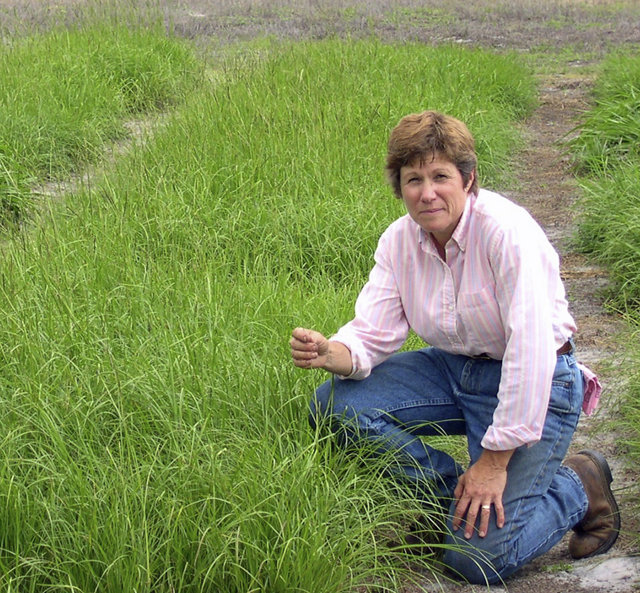
Ann Blount, UF/IFAS Forage Specialist developed a Pensacola cultivar called UF Riata that is less daylenght sensative so it has a longer growing season than other bahia varieties. Photo credit: Marisol Amador, UF/IFAS
–
3 – When to Plant
For the past few years February has been the month when we experience a fairly dramatic warm up, but don’t get too excited. Young tender seedlings are very vulnerable to frost damage. While the planting date ranges in the chart below are fairly lengthy, there are two primary times to plant warm season forages: mid-March through mid-April or mid-June-July. The primary reason to skip May and early June, is that these are typically when we get hot and dry with high pressure systems sitting over us. You need the combination of good soil moisture for seed germination, and regular rainfall for the first few weeks to keep seedlings alive until a root-system can develop. No mater what the chart says, “If it is dry as a bone, POSTPONE.” While you may have adequate moisture and rainfall to plant in late summer or early fall, the shorter days reduce growth, and the plants need time to store up nutrients for winter dormancy after the first frost.
The chart below provides some of the more common varieties that livestock producers plant in this region. The specific species you pick does alter the “best” planting dates.
4 – Start Clean & Firm
Whether you plant from seed or vegetative materials, you want to make sure you have done everything you can to prevent weed competition. The publication Weed Management During Pasture Establishment provides a good overview, but the truth is that there are not any options for preemergence herbicides for seeded forage crops. So you have to make sure you start as clean as possible. If you are going to plant into a field that has been some other type of grass or grass weed, the best option is to spray glyphosate in early fall or spring when those grasses are actively growing, before preparing the land for planting. Disking only once or twice right before planting will not eliminate weed issues. While it may kill existing plants, the seed bank is still there. Winter is a good time to start disking fields to allow those seeds to germinate in ealry spring, and then come back and disk again closer to planting time. It may take a few rounds of disking, resting, weed sprouting, and disking again to truly reduce the weed population. Whether you choose to use a combination of herbicides and cultivation, or multiple rounds of cultivation and fallow time, the point is to try to reduce the competition before the desired forage crop is actually planted.
–
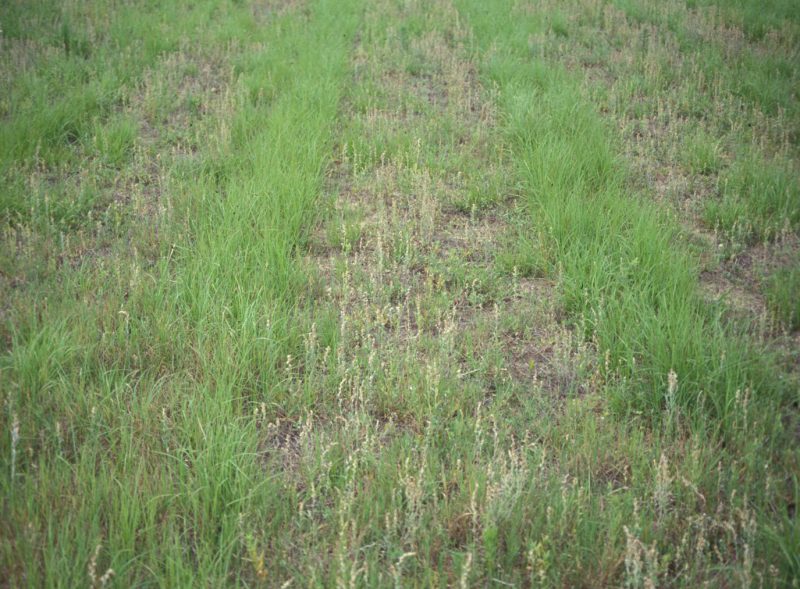
What went wrong here? The grass only came up where the tractor tires provided a firm seedbed. Credit: Carrol Chambliss, UF/IFAS Archive
The other issue I have seen is poor land preparation. You need a fairly firm soil to plant into. Soil normally acts lick a wick, drawing moisture to the surface. But when you disk the land and make it “fluffy,” it is full of air and will dry out very quickly. It also tends to be rough and very uneven. You will be driving across this field after planting for years to come, so you want it to be as smooth and firm before planting.
Dr. Carrol Chambliss was the Forage Specialists for many years in Florida. He helped numerous livestock producers understand the key concepts of pasture establishment with the slide photos he took throughout his career. The following picture is a collection of his slides showing the four major steps to adequate land preparation for planting. Plowing is not necessarily required, but it does bury weed seed near the soil surface, and break up surface compaction better than disking alone.
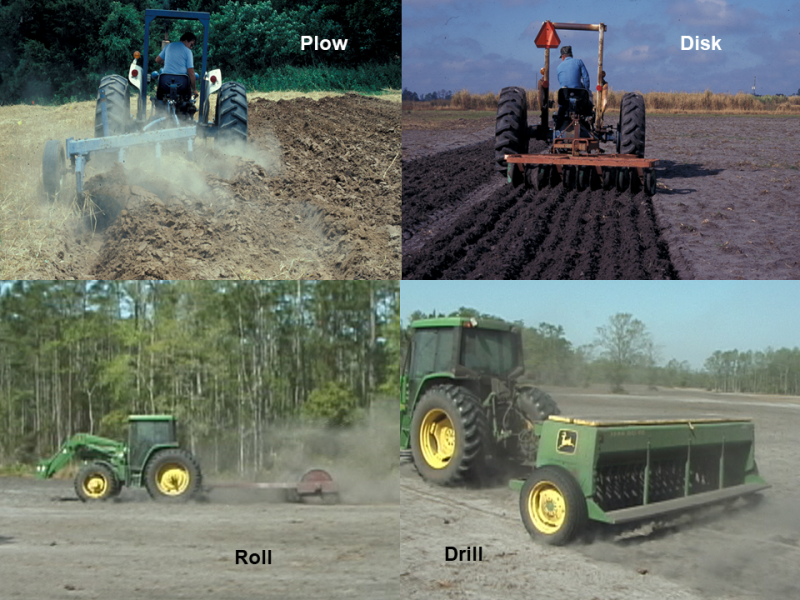
There are many ways to prepare land for pasture planting, but the commonly used steps shown in this photo are plow, disk, roll, and drill. Credit Carrol Chambliss, UF/IFAS Archive
There is also an option that can save on equipment costs that combines some of these steps into one pass planting. If you only have a disk, you might consider adding a cultipacker, so you can get a firm seed bed, and plant small forage seeds at the recommended 1/4-1/2″ depth. If you only have a spreader and a disk, then disk and drag the field, and then wait to allow a few rain events to firm the soil back up before broadcasting seed.
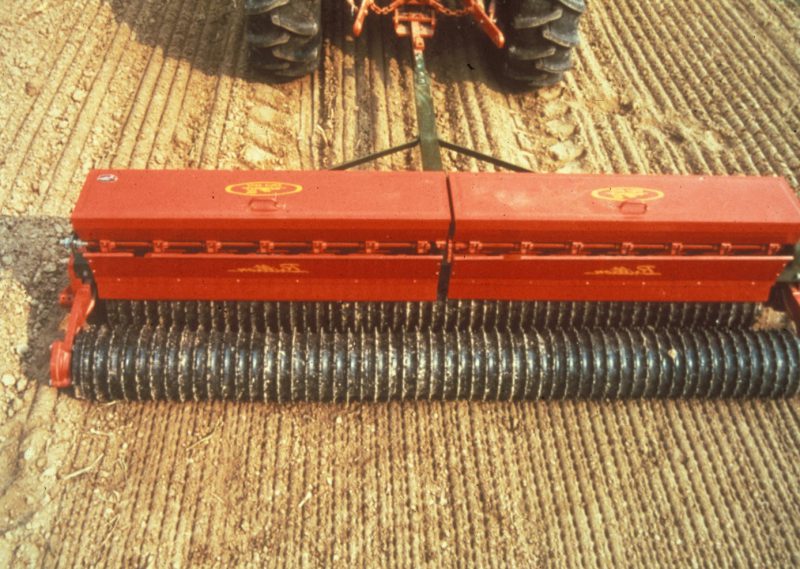
The cultipacker seeder firms up the seed bed while planting small forage seeds at the correct depth in a single pass. Credit: Carrol Chambliss, UF/IFAS Archive
–
5 – Fertilize
Seedling crops need immediate access to nutrients near the soil surface. The seed itself has enough stored energy to start the plant, but after the forage has emerged and developed a root system, it needs immediate access to nutrients, especially nitrogen (N). Crops of all types have a target pH best suited for nutrient uptake for that specific crop. While it is a common practice to incorporate fertilizer at or before planting, the best method is to wait until you have actively growing plants emerged a few inches tall, with a functioning root system before spreading fertilizer. Plus if you have a poor stand for some reason, you can at least save the money for fertilizer for a later successful planting.
The best course of action is to collect soil samples from random locations all across a field and have it analyzed by the UF/IFAS Soil Lab before planting. This way you know what it is needed in advance. If you simply broadcast lime or dolomite to correct low pH, it can take up to six months to incorporate with rainfall. But, if you apply the lime or dolomite before you disk, you can mix it right into the root zone of the soil. The soil test will also provide recommendations to help you order the precise, customized blend of fertilizer needed for your specific field from the supplier. You will receive instructions on how to apply the fertilizer in a split application. Tiny plants don’t need all of the fertilizer applied at once, and you will reduce risk leaching from heavy rainfall.
–
6 – Minimize Weed Competition
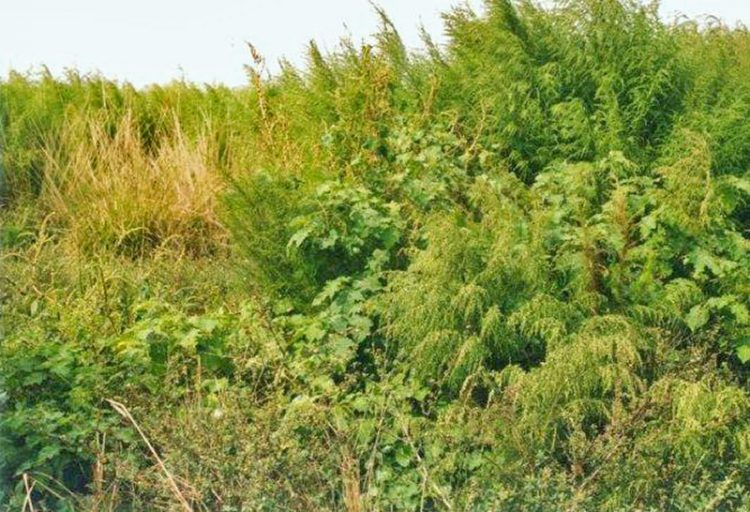
Many weeds grow faster and taller than forages. For newly established pastures, minimizing weed competition is critical. This pasture was planted and neglected through the summer. Credit: Doug Mayo, UF/IFAS
Seedling plants can be vulnerable to herbicide injury. This is especially true for bahiagrass. As a general rule, you need new crops to be at least six inches tall before applying herbicides. This is why it is so important to reduce the weed population in a field prior to planting. If weeds do get a jump start on the forages you plant, you can always mow to allow more light to reach the target crop. The publication Weed Management in Pastures and Rangeland provides a lot of information about herbicides labeled for use on forage crops in Florida. Once the grass has emerged and grown for a month, there are a number of options to control most annual weeds in pastures.
–
7 – Don’t Graze Too Soon or Too Hard
The last step seems fairly straight forward, but I have seen issues with grazing too soon, especially with horses that have top and bottom front teeth. This is pretty easy to test. Just reach down and pull on the grass plants. If you pull up the plant, or feel the roots give way it is too soon. In general you can use height as a guide with most forages needing to reach 6-12″ before gazing begins, but for larger plants like millet and sorghum hybrids 20-24″ is recommended. Just remember you have made a significant investment in establishing this pasture. Don’t rush to graze it off, or leave the animals on it to long. This is a baby plant, so make sure it has adequate time to recover after grazing, to make sure you have good survival. In general, you should plan on using these newly established fields as supplement for other pastures, not the primary source for at least the first year.
These seven steps can’t prevent every problem, but will help you avoid major issues. The school of hard knocks is a hard and expensive way to learn. Don’t try to figure all of this out by yourself. Talk with your local county agent, other ranchers, and your local farm supply dealer to find out what works best in your local area, before investing hundreds of dollars per acre. You want to get this right the first time.
–
For more information, use the following links to UF/IFAS Extension publications:
Forage Planting and Establishment Methods on Prepared Seedbed
Budgets for Pasture Establishment: Seeded and Vegetative
Weed Management During Pasture Establishment
Five Basic Steps to Successful Perennial Pasture Grass Establishment From Vegetative Cuttings
Fertilizing and Liming Forage Crops
Weed Management in Pastures and Rangeland
- Northwest Florida Beef Cattle Conference & Trade Show – February 11 - December 19, 2025
- Friday Feature:The Sears Catalog –How Rural America Shopped before the Internet - December 19, 2025
- November 2025 Weather Summary & Winter Outlook - December 5, 2025

